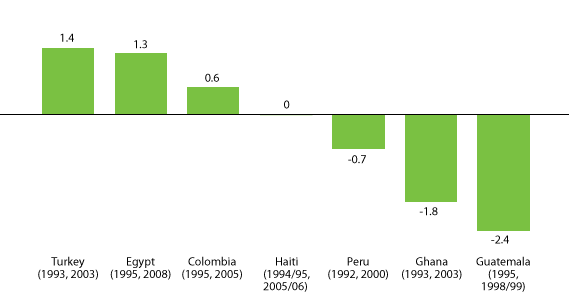
Increased Overweight Prevalence and Chronic Disease Risk Among the Poor in Developing Countries
(May 2012) Globally, the prevalence of overweight and obesity has increased at alarming rates—with 1.5 billion adults overweight worldwide.1 The growing prevalence of overweight in developing countries has helped propel an upsurge in chronic, noncommunicable diseases including diabetes and hypertension. However, the burden of overweight is not distributed equally: There are significant social and geographic patterns and inequalities.
The relationship between overweight and socioeconomic status (SES) is dynamic and complex. Two new studies published in the American Journal of Epidemiology and the International Journal of Obesity used data on lower-income countries from the Demographic and Health Surveys to examine changing patterns in overweight and SES.2 Due to limited information on height and weight, they analyzed data on women between the ages of 18 and 49 with young children.
Annualized Difference in Overweight Prevalence Growth Rate, by Wealth Quintile

Note: Negative numbers indicate faster increase in overweight among the wealthy. Positive numbers indicate faster increase in overweight among the poor.
Source: Jessica Jones-Smith et al., “Is the Burden of Overweight Shifting to the Poor Across the Globe? Time Trends Among Women in 39 Low- and Middle-Income Countries (1991-2008),” International Journal of Obesity (forthcoming).
Their results indicate that in most developing countries, wealthier groups have higher overweight prevalence. But in some countries, overweight prevalence increased faster among less-wealthy groups. According to the study authors, “These findings have important implications for future trends in the social distribution of risk factors for chronic disease in lower-income countries.”
Part of the reason behind changing overweight patterns may be due to economic development. Analyses on population-based surveys of 37 countries over time show that countries with higher gross domestic product (GDP) had faster increases in overweight prevalence among less-wealthy groups. These changes mimic patterns in higher-income countries, where lower SES groups disproportionately suffer from overweight. And among the higher GDP countries, lower income inequality was associated with a higher increase in overweight prevalence among less-wealthy groups. “These findings may suggest that the increased resources that most likely accompany wealth do not have a universal effect on overweight risk, even at the same level of economic development,” the authors report.
Context Matters
A number of contextual factors could accompany changes in overweight prevalence. Perhaps the less-wealthy groups are only now experiencing environmental conditions that higher-wealth groups experienced several decades ago, such as easy access to energy-dense foods. Research shows that fast-food availability is related to obesity.
However, recent evidence from the United States argues that neighborhood fast-food availability is not related with reported consumption of fast food. Using data from the U.S. National Longitudinal Survey of Adolescent Health on young adults, researchers reporting in BMC Public Health looked at how the availability of neighborhood fast-food outlets relates to frequency of fast food consumption.4 Whether the neighborhood was nonurban, suburban, or urban, they found no relationship between availability and consumption. One explanation could be “that young adults more often purchase and consume fast food in settings other than their residential neighborhoods, such as school or workplace locations,” note the authors.
But what about prior research that indicates a relationship between the availability of fast food and obesity? Perhaps fast food restaurants are found more often with other neighborhood or environmental characteristics that influence obesity. For example, since fast-food restaurants depend on drive-thru business, neighborhoods with more fast food available may have more roads that limit how easy it is to walk.
These studies demonstrate an increased overweight and chronic disease risk factor burden among the poor in countries with higher economic development. They also highlight the current gaps in understanding how social, cultural, economic, and contextual factors influence overweight risk—and fruitful avenues for future research.
Brian Houle is assistant director of the Colorado University Population Center. This article is part of PRB’s CPIPR project, funded by a grant from the Eunice Kennedy Shriver National Institute of Child Health and Human Development. Lori Hunter is liaison from the University of Colorado’s Population Center to CPIPR.
References
- World Health Organization, “Obesity and Overweight Fact Sheet” (2011), accessed on May 10, 2012.
- Jessica Jones-Smith et al., “Cross-National Comparisons of Time Trends in Overweight Inequality by Socioeconomic Status Among Women Using Repeated Cross-Sectional Surveys from 37 Developing Countries, 1989-2007,” American Journal of Epidemiology 173, no. 6 (2011); and Jessica Jones-Smith et al., “Is the Burden of Overweight Shifting to the Poor Across the Globe? Time Trends Among Women in 39 Low- and Middle-Income Countries (1991-2008),” International Journal of Obesity (forthcoming).
- Andrea Richardson et al., “Neighborhood Fast Food Restaurants and Fast Food Consumption: A National Study,” BMC Public Health 11, no. 543 (2011).
